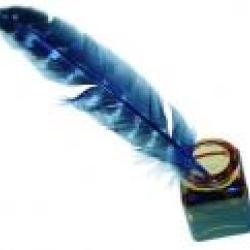Source Institutions
Source Institutions
Add to list Go to activity
Activity link broken? See if it's at the internet archive

In this activity, learners explore how pens have been engineered and re-engineered over time. Learners work as a team to develop a working pen out of everyday items. They sketch their plans, identify materials they'll need for construction, build their pen, test it, and present their design to the group.
- Under 5 minutes
- 1 to 2 hours
- $10 - $20 per group of students
- Ages 8 - 18
- Activity, Lesson/Lesson Plan
- English
Quick Guide
Materials List (per group of students)
- Student Resource Sheets
- Student Worksheets
- Straws
- Paper
- String
- Tape
- Wire
- Paper clips
- Feathers/quills
- Glue
- Foil
- Plastic wrap
- Leaves
- Wooden sticks
- Water
- Washable liquid watercolor or diluted washable paint
- Flour or corn starch (can be used as a thickener)
- Sponge
Subjects
-
Engineering and Technology
-
Engineering
- Chemical Engineering
- Mechanical Engineering
- Metallurgy and Materials Engineering
-
Technology
- Information and Communication
-
Engineering
-
Physical Sciences
-
Chemistry
- Solutions
-
Motion and Forces
- Machines
- Gravity
-
States of Matter
- Liquids
- Structure and Properties of Matter
-
Chemistry
-
The Nature of Science
-
The Scientific Process
- Asking Questions
- Conducting Investigations
- Gathering Data
- Formulating Explanations
- Communicating Results
-
The Scientific Process
-
The Nature of Technology
-
Technology and Society
- Impacts of Technology
- Technology and History
-
The Design Process
- Research and Development
- Invention and Innovation
- Problem Solving
- Troubleshooting and Maintenance
-
Technology and Society
Informal Categories
- Arts and Crafts
Audience
To use this activity, learners need to:
- see
- read
- touch
Learning styles supported:
- Involves teamwork and communication skills
- Links STEM to other topics of interest such as arts and humanities
- Involves hands-on or lab activities
Other
Components that are part of this resource:
Includes alignment to state and/or national standards:
This resource is part of:
Access Rights:
- Free access
By:
Rights:
- All rights reserved, IEEE,
